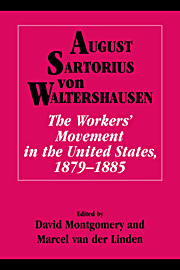Book contents
- Front Matter
- Contents
- Acknowledgments
- 1 Introduction
- 2 August Sartorius von Waltershausen (1852–1938), German Political Economy, and American Labor
- 3 The Trade Unions in the United States of America
- 4 Boycotts: A New Trade Union Weapon in the United States
- 5 Relief Funds in the United States
- 6 Bibliography of Sartorius von Waltershausen's Writings
- Index
4 - Boycotts: A New Trade Union Weapon in the United States
Published online by Cambridge University Press: 22 September 2009
- Front Matter
- Contents
- Acknowledgments
- 1 Introduction
- 2 August Sartorius von Waltershausen (1852–1938), German Political Economy, and American Labor
- 3 The Trade Unions in the United States of America
- 4 Boycotts: A New Trade Union Weapon in the United States
- 5 Relief Funds in the United States
- 6 Bibliography of Sartorius von Waltershausen's Writings
- Index
Summary
The craft guilds and journeymen's associations, which for centuries had framed the socioeconomic organization of artisans and their wageworkers, were destroyed by technical innovations and the victory of free competition. But considering the extent of the transformation of economic structures since their heyday, more of the spirit that imbued them survives in modern manufacturing industry than might be expected. Extreme economic individualism, whose triumph was proclaimed enthusiastically at the dawn of the bourgeois epoch in economic life, has not become a reality. The intrinsic value of the principle of collectivism is too great for it to be overwhelmed by the economic revolution of the last century. Taking account of the new age, it has merely appeared in a new guise.
That we can recognize some characteristics of the guilds in today's employers' and workers' associations is only partly due to the nature of the association as a form of organization, which tends to become particularly rigid in the economic sphere. What also matters is that supply and demand influence the prices of goods and labor among privately owned modern businesses as much today as they did a century ago, that markets for a product sold at a certain price are finite, and that every economic combination of whatever kind is constrained by these facts. And finally, the force of tradition and custom, which is often more powerful and persistent than any law, will also play a role (although it must be said that many gradations can be distinguished here).
- Type
- Chapter
- Information
- The Workers' Movement in the United States, 1879–1885 , pp. 153 - 170Publisher: Cambridge University PressPrint publication year: 1998

